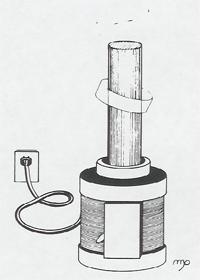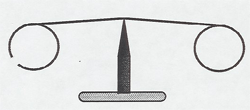E.5.3 Lenz's Law
Jumping Ring
A light aluminum ring, when placed on the iron core sticking out of a large AC electromagnet, is ejected violently into the air when the electro-magnet is activated. The conceptual explanation is that the AC magnet is continually reversing polarity, and induces a voltage in the ring so the ring's magnetic field continually opposes (repels) that of the iron core.
Copper rings and split rings are available to test also. A heavier copper ring will float midway up the iron core. When the ring is forced down on the iron core, it becomes very hot. A split ring will not move; it is not a complete circuit.

Magnetically Damped Pendulum
A pendulum with various disk is arranged to swing through the poles of a powerful permanent magnet. A solid aluminum disk is stopped on the first pass. An aluminum disk slotted to reduce eddy currents is moderately damped, and a cardboard disk swings freely.
Various rectangular plates can be released to fall through the poles of the magnet. An aluminum plate slides viscously, a slotted plate more rapidly, and a cardboard plate is unaffected.
Russian Version
Two rings are balanced on an arm which swings freely on a bearing. When a magnet is thrust into one ring, it is repelled away. (You can use this to illustrate the answer to the question in connection with the Faraday demonstration E.5.1, "Where does the energy come from that moves the galvanometer needle?"). When the magnet is pulled out, the ring is attracted towards it. The other ring is split; thrusting a magnet in and out has no effect on it.

Osheroff Demonstration
A copper plate is cooled with liquid nitrogen to improve it's conductivity. A falling magnet bounces without hitting the plate and lands on it's edge.